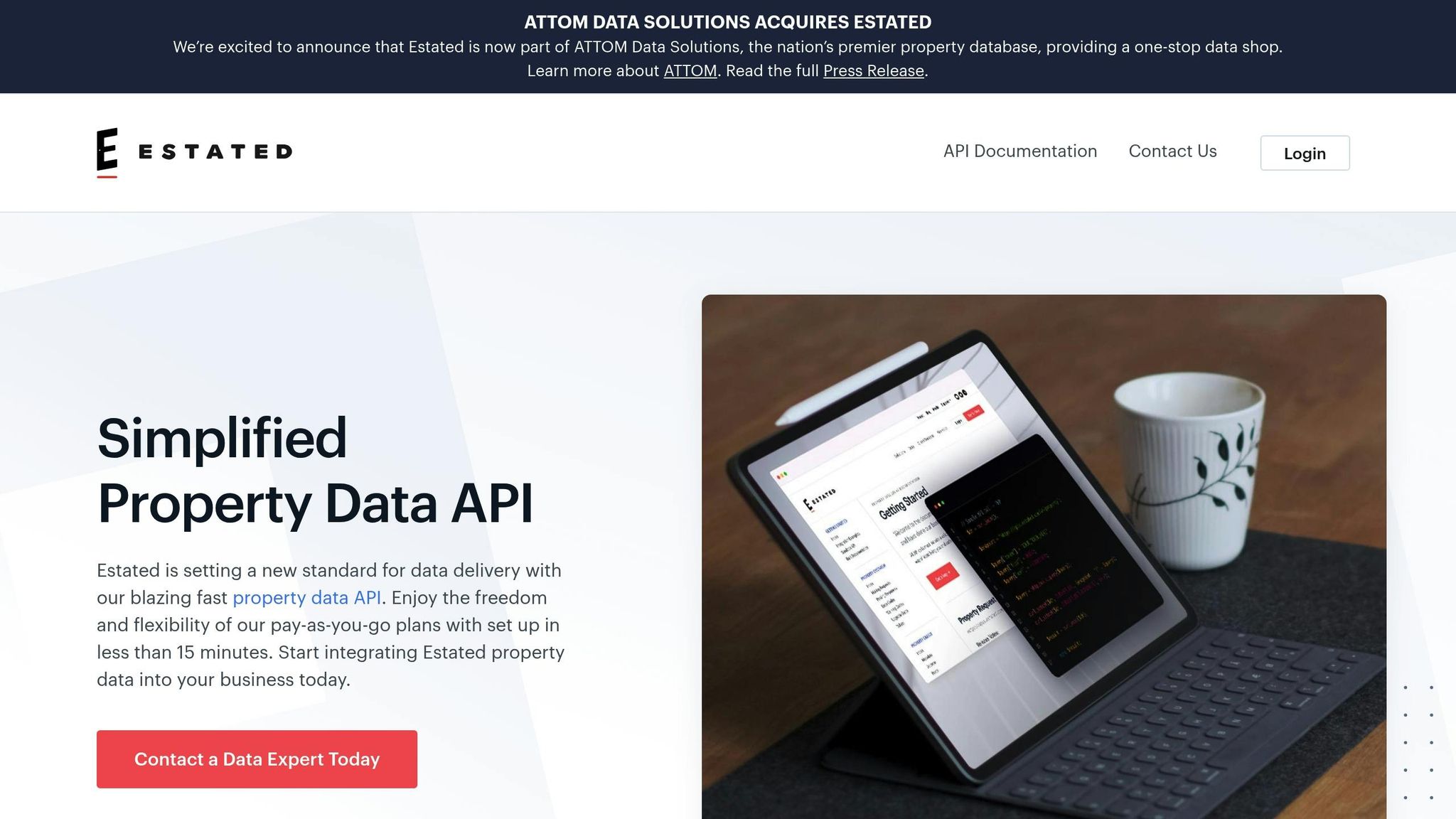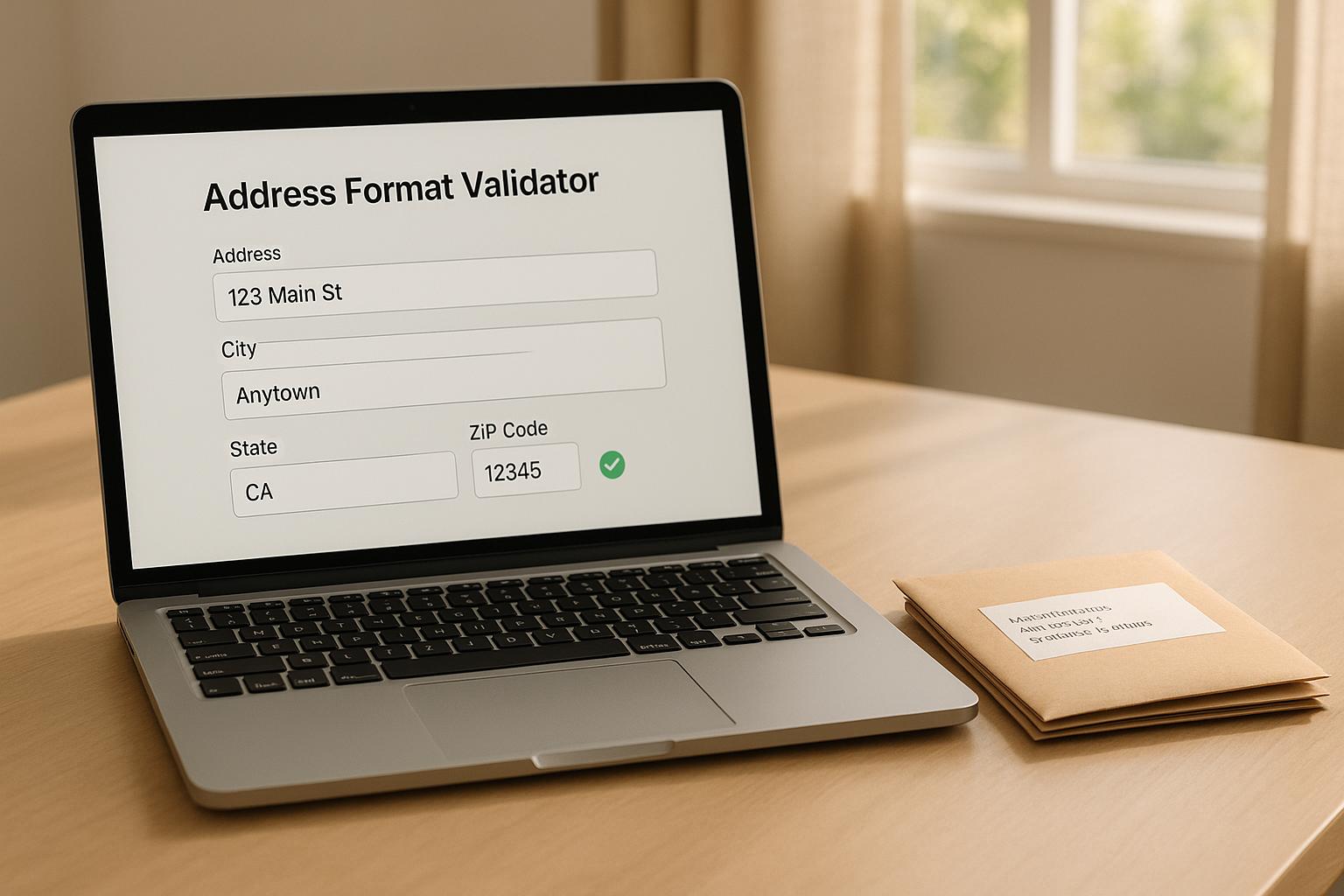Real estate APIs transform how property data is managed by automating tasks, connecting systems, and providing real-time updates. They save time, reduce errors, and eliminate manual processes by seamlessly pulling property details, market trends, and contact information from multiple sources into a unified pipeline.
Key Takeaways:
- Automation: APIs handle data collection, validation, and updates, removing repetitive manual work.
- System Integration: They link tools like MLS systems, CRMs, and analytics platforms, breaking down data silos.
- Real-Time Access: Get instant updates on property values, market trends, and ownership details.
- Data Accuracy: APIs enrich data, verify records, and keep information up-to-date.
- Scalability: They efficiently process large data volumes, supporting business growth.
By integrating APIs, real estate professionals can streamline workflows, improve decision-making, and stay competitive in fast-moving markets.
Get Real Estate Property Data using Estated‘s API | Python Tutorial Part 2

Problems with Manual Real Estate Data Management
Managing real estate data manually can create a host of challenges that slow down operations and reduce accuracy. These inefficiencies make a strong case for adopting API-driven solutions to simplify and improve data workflows.
Disconnected Data Sources
Real estate professionals often juggle multiple systems that don’t talk to each other. For example, property listings might be stored in one database, client contacts in a CRM, and market analytics in yet another platform. Financial records, compliance documents, and property histories are scattered across various software tools, creating a fragmented landscape.
This lack of integration leads to data silos, where critical information is locked away in separate systems. Agents are left manually transferring data between platforms, increasing the risk of missing updates or overlooking key details – especially when property statuses change across systems.
Without a unified system, getting a clear view of market conditions or portfolio performance becomes a logistical nightmare. Decision-makers are forced to rely on incomplete reports because the data is spread across incompatible systems, each requiring separate logins, interfaces, and manual extraction processes. These silos not only waste time but also make it harder to act on insights – a challenge automation can address, as discussed in the next section.
Manual Work and Errors
When data is managed manually, human error becomes inevitable. Tasks like data entry and spreadsheet updates are prone to mistakes, leading to problems with version control and outdated records – especially when multiple team members are working on different versions of the same file.
Manual processes also introduce delays. In real estate, timing is everything, but collecting and verifying data manually can take days or even weeks. By the time the data is ready, market conditions may have shifted, rendering the information less useful for decision-making.
Over time, the quality of manually managed data declines. Contact details become outdated, property information changes without being updated across systems, and duplicate records pile up. This data decay negatively impacts marketing efforts, lead generation, and market analysis, making it harder to stay competitive.
Growth Limitations
Manual systems simply can’t keep up with growth. As data volumes increase, manual processes lead to delays and rising costs, creating bottlenecks that prevent businesses from scaling. This makes it difficult to take on new clients or expand into additional markets.
Modern real estate operations require real-time data access – whether it’s current market trends, property valuations, or client information. Manual systems fail to deliver this immediacy, putting businesses at a disadvantage compared to competitors who have automated their workflows.
Additionally, the cost of maintaining manual systems grows significantly as businesses scale. More staff hours, extra software licenses, and constant error corrections can eat into operational budgets. For many growing real estate firms, these costs become unsustainable, leaving fewer resources for client service and business development. These inefficiencies highlight why automated, API-driven solutions are becoming essential for staying competitive in the industry.
How Real Estate APIs Change Data Pipelines
Real estate APIs are reshaping how data flows through systems, addressing the inefficiencies of manual data management. Instead of relying on disconnected processes that often lead to errors and delays, APIs create direct links between platforms, automate repetitive tasks, and provide real-time updates. This shift moves the industry from reactive data handling to a more streamlined, automated approach, fundamentally improving how professionals access and use information.
This change happens on three key fronts: system integration, task automation, and real-time data access. APIs eliminate bottlenecks, simplify workflows, and ensure data is always accurate and up-to-date.
Connecting Different Systems
APIs break down data silos by enabling standardized communication between platforms that were previously isolated. For example, instead of manually transferring property details from your MLS system to your CRM and then updating your marketing tools separately, APIs synchronize this data across all systems automatically.
This integration relies on structured data exchange protocols to maintain consistency. If a property’s status changes – like moving from "available" to "under contract" – the API ensures all connected systems reflect this update instantly.
The result is a unified data ecosystem where information flows effortlessly. Marketing campaigns automatically align with current inventory, client communications are always accurate, and financial reports reflect real-time deal updates. This interconnected system transforms scattered data into actionable insights, empowering better business decisions.
Take BatchData‘s property search API as an example. It connects property data directly to your existing systems, eliminating the need to toggle between multiple platforms. Instead, property information, contact details, and market analytics are delivered through a single access point, seamlessly integrating into your workflows and setting the stage for task automation.
Automating Data Tasks
Once systems are connected, automation takes over to handle the tedious, repetitive tasks that often consume valuable time. APIs can manage processes like data collection, cleaning, validation, and enrichment automatically, freeing up your team to focus on more strategic activities like client engagement and deal negotiations.
For instance, enriching contact data – like finding updated phone numbers, email addresses, or property ownership details – traditionally requires hours of manual effort. APIs can accomplish this in seconds, transforming basic information into comprehensive, up-to-date records.
Data accuracy improves continuously with APIs. They validate phone numbers, verify addresses, and flag outdated or incorrect information as part of their routine operations. This ensures your database stays reliable, avoiding the common pitfalls of manual updates where data often becomes outdated over time.
Automation also simplifies complex tasks like lead scoring and market analysis. APIs can evaluate incoming leads based on criteria such as property values, ownership history, and contact quality, then direct qualified prospects to the right sales team. Similarly, APIs can compile market trends from multiple sources automatically, delivering insights directly to dashboards without requiring manual effort.
Providing Real-Time Data Access
Real-time data access is a game-changer for real estate professionals, enabling faster responses to market opportunities. Instead of waiting for periodic updates or reports, APIs provide instant access to property values, recent sales, and market trends. This speed enhances decision-making and keeps professionals competitive.
Property information updates in real time, reflecting changes like new listings, price adjustments, or recent sales across all platforms immediately. This is especially critical in fast-paced markets, where timing can make or break a deal.
The benefits extend to client interactions as well. Imagine a potential buyer calls about a property – within moments, you can access details like current ownership, comparable sales, neighborhood trends, and even the listing agent’s contact information. This level of preparedness not only improves the client experience but also boosts conversion rates.
BatchData’s data delivery ensures that property searches, contact enrichment, and market analytics are always up-to-date. This immediacy supports critical, time-sensitive decisions, whether you’re crafting a competitive offer, evaluating an investment property, or planning market entry strategies. Accurate, real-time data gives you the edge needed to succeed in today’s dynamic real estate landscape.
Main Benefits of Real Estate APIs
Real estate APIs bring tangible advantages, revolutionizing the way professionals handle data, streamline operations, and adapt to shifting market dynamics. These benefits lay the groundwork for broader operational improvements.
Improved Data Quality and Accuracy
APIs enhance data by filling in gaps and verifying records with detailed information like ownership history, property attributes, market valuations, and up-to-date contact details.
One standout improvement is in contact data. Traditional methods often produce outdated or incomplete information, but APIs validate and enrich this data in real time using multiple sources. For instance, BatchData ensures real-time verification of contact details, which reduces issues like bounced calls and leads to more productive interactions.
Additionally, APIs contribute to more accurate property valuations. By pulling data from diverse sources, they generate market-aligned estimates. This helps agents set competitive prices, supports investors in evaluating opportunities, and aids lenders in assessing risks with greater confidence.
Managing Large Data Sets Efficiently
The real estate industry deals with massive data volumes that demand automated processing systems equipped with error-checking and retry capabilities. APIs are designed to handle this, scaling dynamically to ensure smooth, accurate operations – even during high-demand periods like seasonal buying spikes.
BatchData, for example, processes bulk property searches efficiently, delivering enriched data in standardized formats that integrate seamlessly with existing tools. This automation not only saves time but also allows professionals to respond more effectively to market demands.
Quicker Market Adaptation
With real-time access to data, APIs enable professionals to react quickly to market changes. Instant insights make it easier to adjust pricing, analyze trends, and seize time-sensitive opportunities in competitive markets. This ability to act swiftly offers a distinct edge in staying ahead of market fluctuations.
sbb-itb-8058745
How to Add Real Estate APIs to Your Data Pipeline
Integrating real estate APIs into your data pipeline is a process that demands careful planning and execution. From understanding your specific requirements to selecting the right provider and ensuring smooth implementation, each step plays a critical role in building a reliable system.
Identify Your Data Needs
Before diving into API integration, start by defining your project’s goals and data requirements. This step lays the groundwork for everything else, as it determines the type of data you’ll need and how it will be used across your organization.
First, clarify your core data needs. Are you looking for basic property details like addresses and square footage? Or do you need more detailed information such as school districts, neighborhood demographics, and historical sales records? Different teams within your organization may have varying requirements. For instance:
- Sales teams might prioritize lead generation and contact enrichment.
- Analysts may need bulk property data for market trends and research.
- Investment firms often rely on real-time valuations and ownership histories.
- Compliance teams may focus on verification and fraud prevention features.
Next, consider how the data will be used. Do you need real-time API calls for individual property lookups, or will bulk data delivery for large-scale analysis be more effective? Some businesses may require both, depending on their workflows. These considerations will help you determine the type of API architecture and pricing model that aligns with your needs.
By clearly defining these requirements, you’ll have a solid foundation for evaluating providers and ensuring a smooth integration process.
Select the Right API Provider
Choosing the right API provider involves assessing both technical capabilities and how well their offerings align with your business needs. The ideal provider will offer reliable uptime, detailed developer documentation, and comprehensive data coverage.
One standout example is BatchData, which provides flexible real estate API solutions. Their pay-as-you-go pricing model is particularly appealing for businesses that need scalability without committing to fixed subscription costs.
When evaluating providers, dig into their data sources and update frequency. For instance, BatchData offers real-time verification and enrichment, which ensures that the data you receive is both accurate and up-to-date. This is especially important for maintaining data quality – a key factor discussed earlier.
Also, consider the technical integration requirements. Look for providers offering RESTful APIs with clear documentation, SDKs for popular programming languages, and responsive technical support. The ability to customize data delivery formats and integrate with your existing tools can streamline implementation and reduce ongoing maintenance.
Set Up and Monitor the Integration
Once you’ve chosen a provider, focus on implementing the system and monitoring its performance over time. A successful integration requires attention to testing, validation, and continuous oversight.
Start with thorough endpoint testing in a controlled development environment. Test for successful responses, error handling, and rate limits to ensure your system can handle unexpected scenarios or high-traffic situations.
During setup, data validation is crucial. Automate checks to verify that incoming data meets your quality standards and aligns with your business rules.
Establish monitoring systems to track key metrics like API performance, response times, error rates, and data quality. Set up alerts for unusual activity, such as increased errors or slower response times, so you can address issues quickly. Many organizations use dashboard tools to gain real-time insights into API usage patterns and system health.
Pay close attention to rate limit management. Design your integration to handle rate limits effectively by spacing out requests, implementing retry logic, and using queue management to avoid disruptions.
Finally, plan for ongoing maintenance and updates. API providers may update endpoints, add new data fields, or change response formats over time. Stay informed about these changes, test updates in a staging environment, and roll them out to production only after thorough validation. This proactive approach will ensure your integration remains reliable and efficient as your needs evolve.
Common Uses for Real Estate APIs
Real estate APIs streamline tasks and provide critical data, allowing professionals to generate leads faster and make more informed decisions.
Automated Lead Generation
With APIs, property records can be enriched instantly with details like ownership history, property specifications, and neighborhood information. This eliminates the need to manually search multiple websites or databases for basic details.
Contact enrichment and skip tracing take this process further by providing up-to-date contact information for property owners. For example, BatchData’s skip tracing tools can quickly locate phone numbers, email addresses, and mailing addresses for owners who might be open to selling.
The time savings are substantial. Tasks that once required hours of manual effort can now be completed in seconds using API calls. This efficiency allows real estate teams to handle larger volumes of leads without sacrificing data accuracy or completeness.
But the benefits of APIs extend beyond just lead generation.
Market Analysis and Portfolio Management
APIs are also vital for conducting detailed market research and managing property portfolios. Real estate analysts and investment firms can use bulk data delivery to access thousands of property records at once, enabling them to analyze trends and make data-driven investment decisions.
Market analysis often requires consistent, up-to-date information across numerous properties and regions. APIs simplify this process by delivering standardized data formats, making it easier to compare properties, monitor market trends, and identify opportunities. This large-scale analysis is possible without the need for manual intervention.
For portfolio management, APIs provide automatic updates on property data, helping managers track changes in property values, neighborhood developments, and market alerts. BatchData’s custom datasets feature even allows users to request specific data combinations tailored to their unique needs, ensuring that analysts can focus on metrics most relevant to their strategies instead of sifting through generic data.
Compliance and Fraud Prevention
In addition to simplifying data processes, APIs help ensure compliance and reduce fraud in real estate transactions. By automating verification procedures, APIs address critical challenges in maintaining data integrity and meeting regulatory standards.
Phone number verification ensures that contact details are accurate and legitimate, which is essential for mortgage lenders verifying borrower information and for agents reaching out to actual property owners instead of fraudulent contacts.
Address verification confirms that properties exist and ensures correct formatting in databases. While this might seem like a minor step, it prevents costly errors in legal documents and maintains data accuracy across systems.
Many compliance regulations in real estate require specific verification processes. APIs can handle these tasks automatically, maintaining audit trails and reducing the manual workload needed to meet regulatory requirements. This is especially valuable for companies managing high transaction volumes, where manual checks would be inefficient.
Fraud prevention is another critical area. As property scams and identity theft become more common, APIs can flag inconsistencies, create audit trails, and protect transactions, ensuring both compliance and security.
Key Points About Real Estate APIs
Real estate APIs have revolutionized workflows by automating and speeding up tasks that once required significant manual effort. For instance, what used to take 30 minutes for contact enrichment can now be done in just 30 seconds. Similarly, development timelines have shrunk dramatically, from months to mere days.
Beyond saving time, the scalability of these APIs is a game-changer. They provide access to extensive datasets, enabling businesses to grow without worrying about data limitations. Take BatchData as an example – it offers over 1 billion data points, covering more than 155 million properties with 800+ attributes, all from a single source. This level of access supports businesses of all sizes, from startups to large enterprises. Additionally, the improved data quality drives better outcomes, achieving 76% accuracy in connecting with property owners. Features like phone verification and address validation ensure the data remains reliable while reducing the risk of fraud.
But APIs do more than gather data – they integrate seamlessly with CRMs, marketing platforms, and custom software. This integration creates workflows that automatically enrich data with actionable insights, allowing teams to concentrate on closing deals rather than managing data.
For companies considering adopting these tools, the competitive edge is undeniable. Businesses leveraging API-driven solutions can develop and roll out new features 60 times faster than those relying on manual methods. In an industry where speed and precision are critical, real estate APIs have become essential for staying ahead.
FAQs
How can real estate APIs reduce errors and improve data accuracy?
Real estate APIs simplify the way data is managed by automating the flow of information between systems. This eliminates much of the manual work, cutting down on errors and ensuring property details, valuations, and transaction records are updated instantly. The result? More precise and dependable data.
When businesses use real estate APIs, they benefit from consistent and scalable data management. This translates to smarter decision-making and smoother workflows. These tools are especially useful for handling large datasets, ensuring accuracy, and speeding up data processing tasks.
How can I integrate a real estate API into my data pipeline?
Integrating a real estate API into your data pipeline can be straightforward if approached step by step. First, figure out exactly what kind of data you need – this ensures the API provides the right information with precision and broad coverage. Once that’s clear, configure the API connection. This includes setting up endpoints, handling authentication, and making sure it works smoothly with your current tools and workflows.
To make things more efficient, consider automating data retrieval using scheduled API calls or triggers. Don’t forget to include error-handling mechanisms to keep your data accurate and reliable. It’s also a good idea to regularly check the API’s performance and the accuracy of the data it delivers. This way, your pipeline remains efficient and scalable, whether you’re working with real-time updates or batch processing.
How do real estate APIs help professionals generate leads and analyze market trends?
Real estate APIs are a game-changer for professionals looking to simplify lead generation. By offering access to real-time property data and advanced filtering options, these tools make it easier to pinpoint high-potential prospects. The result? Less time wasted and more focus on quality leads that actually matter.
When it comes to market analysis, APIs provide up-to-date property values, historical sales data, and insights into market trends. With this information, agents and investors can identify opportunities, make smarter decisions, and refine their strategies using reliable, data-backed insights. By incorporating these tools into their workflows, professionals can automate tasks, improve data accuracy, and expand their operations with ease.



